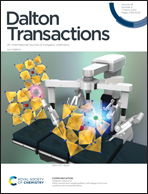Protein binding studies with human serum albumin, molecular docking and in vitro cytotoxicity studies using HeLa cervical carcinoma cells of Cu(ii)/Zn(ii) complexes containing a carbohydrazone ligand†
Abstract
The interaction of two binuclear mixed ligand Cu(II) complexes [Cu(o-phen)LCu(OAc)] (1) and [Cu(o-phen)LCu(o-phen)](OAc) (2) (H3L = o-HOC6H4C(H)![[double bond, length as m-dash]](https://www.rsc.org/images/entities/char_e001.gif) N–NH–C(OH)
N–NH–C(OH)![[double bond, length as m-dash]](https://www.rsc.org/images/entities/char_e001.gif) N–N
N–N![[double bond, length as m-dash]](https://www.rsc.org/images/entities/char_e001.gif) C(H)–C6H4OH-o) and a new mononuclear Zn(II) complex [Zn(HL)(o-phen)(H2O)](OAc)·H2O (3) (H2L = o-HOC6H4–C(H)
C(H)–C6H4OH-o) and a new mononuclear Zn(II) complex [Zn(HL)(o-phen)(H2O)](OAc)·H2O (3) (H2L = o-HOC6H4–C(H)![[double bond, length as m-dash]](https://www.rsc.org/images/entities/char_e001.gif) N–NH–C(
N–NH–C(![[double bond, length as m-dash]](https://www.rsc.org/images/entities/char_e001.gif) O)–NH–N
O)–NH–N![[double bond, length as m-dash]](https://www.rsc.org/images/entities/char_e001.gif) C(H)–C6H4OH-o, o-phen = 1,10-phenanthroline, and OAc = CH3COO−) with human serum albumin (HSA) was studied using fluorescence quenching, synchronous and 3D fluorescence measurements and UV-vis spectroscopy. 3D fluorescence studies showed that the HSA structure was altered at the secondary and tertiary levels upon binding with the complexes. This was further supported by the electronic absorption spectral studies of HSA in the absence and presence of the compounds. The average binding distance (r) between HSA and the complexes was obtained by Förster's resonance energy transfer theory. Complex 3 was structurally characterized by X-ray crystallography. Molecular docking studies indicated that all three complexes primarily bind to HSA in subdomain IIA with amino acid residues such as Arg218 and Lys199 which are located at the entrance of Sudlow's site I. The in vitro cytotoxicities of complexes 1–3 against HeLa cells showed promising anticancer activity (IC50 = 3.5, 3.9 and 16.9 μM for 1, 2 and 3, respectively). Live cell time lapse imaging for 1 was done to capture the dynamic behavior of the cells upon treatment with the complex. Cell cycle analysis by flow cytometry with HeLa cells indicated that 1 and 2 induced cell cycle arrest in the G2/M phase while 3 induced arrest in the G0/G1 phase leading to cell death. Compounds 1 and 2 but not 3 induced apoptosis through the mitochondrial pathway as suggested from the relative p53, caspase3 and bcl2 mRNA levels measured by real-time quantitative PCR analysis.
C(H)–C6H4OH-o, o-phen = 1,10-phenanthroline, and OAc = CH3COO−) with human serum albumin (HSA) was studied using fluorescence quenching, synchronous and 3D fluorescence measurements and UV-vis spectroscopy. 3D fluorescence studies showed that the HSA structure was altered at the secondary and tertiary levels upon binding with the complexes. This was further supported by the electronic absorption spectral studies of HSA in the absence and presence of the compounds. The average binding distance (r) between HSA and the complexes was obtained by Förster's resonance energy transfer theory. Complex 3 was structurally characterized by X-ray crystallography. Molecular docking studies indicated that all three complexes primarily bind to HSA in subdomain IIA with amino acid residues such as Arg218 and Lys199 which are located at the entrance of Sudlow's site I. The in vitro cytotoxicities of complexes 1–3 against HeLa cells showed promising anticancer activity (IC50 = 3.5, 3.9 and 16.9 μM for 1, 2 and 3, respectively). Live cell time lapse imaging for 1 was done to capture the dynamic behavior of the cells upon treatment with the complex. Cell cycle analysis by flow cytometry with HeLa cells indicated that 1 and 2 induced cell cycle arrest in the G2/M phase while 3 induced arrest in the G0/G1 phase leading to cell death. Compounds 1 and 2 but not 3 induced apoptosis through the mitochondrial pathway as suggested from the relative p53, caspase3 and bcl2 mRNA levels measured by real-time quantitative PCR analysis.



 Please wait while we load your content...
Please wait while we load your content...